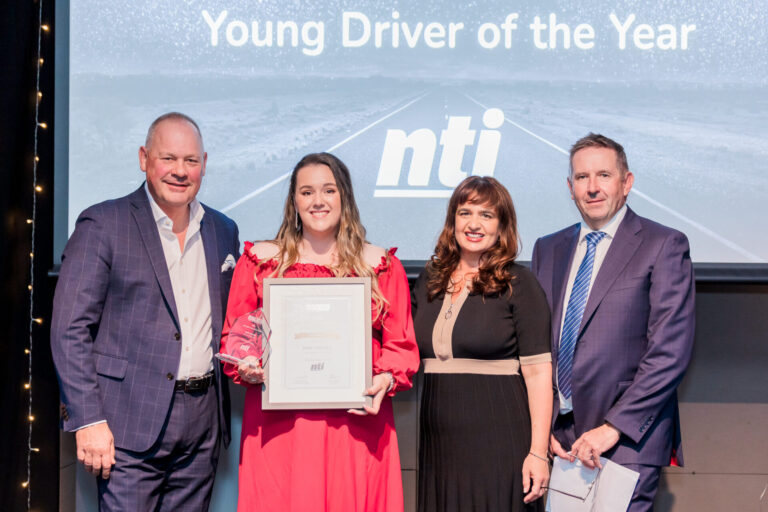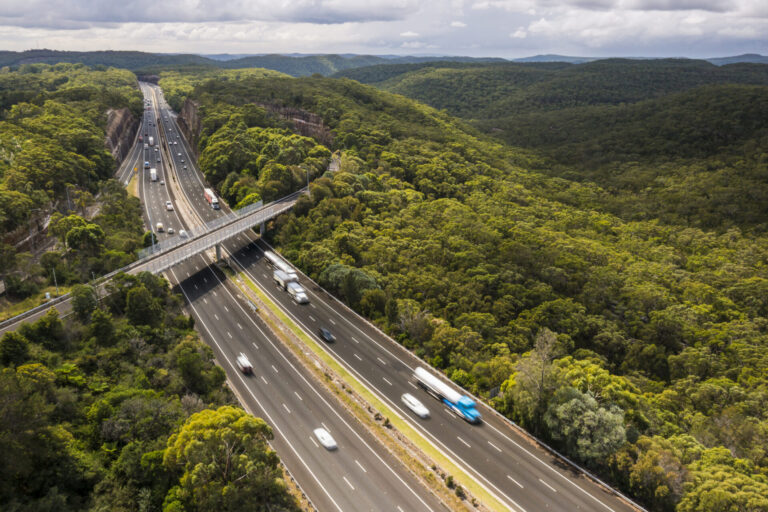Delivering a cost-effective net zero transition and a truck recharging and refuelling strategy and exploring electric and alternative fuel heavy vehicles.
Executive summary
- NSW should accelerate improvements to the road network and heavy vehicle access approvals to enable improved road access for High Productivity Vehicles and Zero Emission Vehicles
- NSW should deliver a Zero Emission Heavy Vehicle Energy Infrastructure Strategy
- NSW should seek a nationally co-ordinated approach to reducing heavy vehicle emissions with the Australian Government delivering a Low Carbon Fuel Standard and a $3.5 billion Clean Transport Fund.
Freight transport accounts for approximately 7 percent of Australia’s total carbon emissions. When combined with passenger transport, the transport sector accounts for approximately 20 percent. Within the 7 percent of total emissions attributable to freight, about 83 percent is a result of road freight.[1]
Transport emissions are the fastest growing sector of carbon emissions and the only sector where total emissions are still rising. All other major sectors either stabilising or achieving reductions.[2]
Australia has emissions reduction targets of 43 percent by 2030 and net zero by 2050, and NSW has emissions reduction targets of 50 percent by 2030, 70 percent by 2035 and net zero by 2050. These are economy wide targets, and do not mean that there will be corresponding reductions of equal proportion from each sector of the economy. However, it is difficult to see a pathway to the 2035 and 2050 targets without achieving larger reductions from transport.
In the 2024 NatRoad member survey over one third of our surveyed members indicated alternate fuels will present a ‘significant challenge’ or ‘challenge’ in 2025.
For an industry operating on tight margins and facing rising costs, the cost barrier of the transition is insurmountable for most operators. Well over 90 percent of road freight businesses are small businesses. Existing funding from Government, while welcome, has almost exclusively only assisted the largest transport operators. Over time the head start for some transport operators risks becoming a competitive disadvantage for other, most likely smaller, operators.
Inquiry into infrastructure for electric and alternative energy source vehicles
NatRoad welcomes the inquiry into infrastructure for electric and alternative energy source vehicles in NSW being conducted by the Legislative Assembly Committee on Transport and Infrastructure.
| Inquiry Terms of Reference That the Committee on Transport and Infrastructure inquire into and report on infrastructure for electric and alternative energy source vehicles in NSW, including: a.) funding and location of electric vehicle chargers or infrastructure for other potential energy fuel sources b.) the viability of alternative energy sources for freight, heavy vehicles and other licenced vehicles in regional communities c.) use of existing infrastructure and measures to ensure a competitive market, including ‘ring fencing’ policies d.) measures to ensure the transition of workers from affected industries and industry standards; and 3.) any other related matters. |
NatRoad has provided clear industry leadership on the opportunities and challenges for reducing carbon emissions in road freight transport and the need for policy reform. This has included:
- Publishing an industry white paper on Australian road freight transport decarbonisation
- Developing recommendations for policy reform set out in our Stronger Economy, Lower Emissions paper
- Providing a set of public resources (Get Fleet Fit) for road freight businesses to guide them through lowering emissions whilst also reducing costs
- Partnering with Heavy Vehicle Industry Australia on the inaugural TruckShowX, Australia’s largest event focused on the move to low and zero emission heavy vehicles.
This submission sets out:
- The main decarbonisation pathways for heavy vehicles
- The need for NSW leadership on improving road access and delivering a Zero Emission Heavy Vehicle Energy Infrastructure Strategy
- The need for national leadership on delivering a Low Carbon Fuel Standard and a Clean Transport Fund
- The viability of alternative emission reduction pathways.
Decarbonisation pathways for heavy vehicles
Reducing carbon emissions from heavy vehicles will require a focus on four key areas:
- Efficiency and optimisation
- Electrification
- Low carbon liquid fuels
- Hydrogen.
There is no silver bullet solution – different pathways will be needed for different road freight tasks.
Efficiency and optimisation
Reducing wasted energy in heavy vehicles is a key component for reducing both costs and emissions.
NatRoad’s Get Fleet Fit resources guide operators through improving their efficiency, which should be based on their duty cycle and what options work best for any specific type of freight task and vehicle. Efficiency includes a wide range of measures, including technology, optimisation, telematics and vehicle solutions such as low rolling resistance tyres.
Moving more with less energy will also depend on significant improvements to heavy vehicle road access approvals.
Governments should ensure that ambition in economy wide climate targets should be backed by strong ambition in improving access for High Productivity Freight Vehicles (HPFVs).
HPFVs reduce the number of individual vehicle trips required to move a freight task, reducing fuel use and reducing emissions. They also achieve better safety outcomes and boost productivity.
Electrification
Battery electric trucks are already available in the Australian market and will increasingly become viable transport options, especially for short haul and urban freight tasks.
The cost and performance of batteries is expected to continue to improve over coming years, which will increase the potential uses and commercial viability of battery electric trucks.
There are a number of NatRoad members trialling electric trucks in NSW and other states.
Low Carbon Liquid Fuels
Considering the age of the heavy vehicle fleet, the nature of some transport tasks especially over longer distances and transporting heavier payloads, drop-in low carbon liquid fuels can provide near term emissions reductions whilst also providing a long-term solution for tasks which may remain beyond the capabilities of electric and hydrogen pathways.
Renewable diesel can be phased into the mix of fossil diesel over time, which provides a pathway for transitioning away from fossil fuels for internal combustion engine vehicles which will remain critical to regional freight tasks.
Hydrogen
Both hydrogen fuel cell electric vehicles and internal combustion engines which can be fuelled by hydrogen are in testing and development. There is already a hydrogen refuelling network for trucks being deployed in New Zealand.
A key barrier is the cost of producing green hydrogen, and hydrogen incentives should take into account the need to scale up hydrogen truck refuelling networks.
Better roads and improving road access
Heavy vehicle access to the road network is regulated by vehicle specifications, including length, width, axle mass and overall combination mass. Beyond general access limits, this means that heavy vehicle access requires either a notice approval for a specific network, or a specific permit for that vehicle to access a specific route.
Vehicles that reduce emissions, including both High Productivity Freight Vehicles and Zero Emission Vehicles, often face the highest regulatory barriers on road access.
NSW has taken positive steps in the right direction, including through both the NSW Heavy Vehicle Access Policy and the NSW Towards Net Zero Emissions Freight Policy (including zero emission heavy vehicle access trial).
These reform directions should be both accelerated and integrated with improvements to infrastructure investment to ensure the right roads and bridges are being upgraded to support improved access. Ultimately, achieving emissions reduction from heavy vehicles will require stronger ambition on access.
Zero Emission Heavy Vehicle Energy Infrastructure Strategy
The complexity of installing electric recharging infrastructure at a trucking depot can be prohibitive. This may involve the cost of recharging infrastructure and batteries, site redevelopment (including the need to reinforce building and pavements), installation of solar panels, increased access to the electricity grid and planning approvals.
It should be noted that the issues increase as a company seeks to increase the speed of the charging infrastructure, which improves vehicle use flexibility. Slower charging (such as overnight) has lower power requirements.
The lack of a shared use fast charging network for trucks limits the use cases for electric trucks and increases the burden for trucking operators wishing to deploy the vehicles.
Similarly, the lack of hydrogen refuelling infrastructure will be a significant barrier for deploying both hydrogen fuel cell electric vehicles and hydrogen internal combustion engine vehicles.
The previous US Administration established an infrastructure strategy to accelerate the deployment of zero emission trucks, with a focus on deployment in stages:
- Establish priority hubs based on freight volumes (2024-27)
- Connect hubs along critical freight corridors (2027-30)
- Expand corridor connections initiating network development (2030-35)
- Achieve national network by linking regional corridors (2035-40).
Any Australian based strategy should be based on Australian considerations, but there is a significant need to address the lack of strategy around the roll out of alternative energy recharging and refuelling infrastructure for heavy vehicles.
Existing zero emission vehicle energy infrastructure
The provision of zero emission heavy vehicle energy infrastructure – such as electric vehicle rechargers – is practically non-existent outside of privately operated depot-based systems.
Existing light vehicle charging infrastructure often lacks the vehicle accessibility needed for heavy vehicles, meaning public and shared use charging infrastructure for electric heavy vehicles is effectively non-existent.
Similarly, the Hydrogen Highways announcement has not delivered outcomes, with the Australian Government withdrawing the remaining Federal funding for the scheme. This reinforces the need for a broader strategy.
National $3.5 billion Clean Transport Fund
NatRoad’s Stronger Economy, Lower Emissions policy paper sets out a clear framework and policy pathways for the net zero transition.
A $3.5 billion Clean Transport Fund to help decarbonise the small business transport industry is the minimum allocation to transitioning the industry. This is a small level of funding in comparison to the billions spent assisting the electricity sector.
The Grattan Institute has calculated the public benefits from accelerating the uptake of zero emission trucks are approximately $4.2 billion, including avoided health costs, avoided CO2 emissions and reduced noise. However, these benefits would require $9.6 billion in costs to business, including infrastructure, vehicles and a time and weight penalty.[3]
NatRoad’s proposed Clean Transport Fund would be less than the projected public benefit, with up to $1 billion provided as financing which would ultimately be repaid. To be funded over seven years, the average annual cost would be $500 million. The cost over the budget forward estimates would be approximately $2 billion.
In seeking a coordinated national approach NSW should seek stronger leadership from the Australian Government and delivery of a Clean Transport Fund.
Viability of emission reduction pathways
The road freight sector keeps regional communities supplied. It is a small business industry, operating on tight margins. Low emission solutions will only be deployed where they are commercially viable.
There are a range of abatement pathways, with the largest emission reduction potential also carrying the highest cost premium.
Figure 1: Emissions reduction and cost premium of different abatement pathways (Mov3ment)[4]

The NatRoad recommended transition strategy for reducing road freight carbon emissions is intended to protect the viability of both small trucking businesses and regional freight. It is not based on imposing a particular technological pathway. Instead, policy reforms should focus on enabling emissions reduction and expanding the choices available to small and regional businesses.
Our recommended policy reforms – including a Zero Emission Heavy Vehicle Energy Infrastructure Strategy, a Low Carbon Fuel Standard, and a Clean Transport Fund would work together to reduce the cost premium of the abatement pathways with the highest emissions reduction potential.
At the same time, our Get Fleet Fit resources provide guidance to industry on accessing emissions reductions which can also provide cost savings, such as improved productivity and optimisation.
Low Carbon Fuel Standard
NatRoad recommends that the states should propose that the Australian Government should develop, consult and implement an Australian low carbon fuel standard.
This should be based on a carbon intensity approach, with stable, predictable and achievable targets and reduction trajectories.
Benefits of this approach would include:
- Incentivising the supply of lower emission fuels. For example, the Californian scheme has been successful in driving increased supply of renewable diesel.
- Reducing emissions from existing vehicles.
- Allows the market to determine lowest cost abatement pathways and provides a long-term abatement trajectory and policy certainty.
- Can work alongside other policy measures and a broader transition strategy.
Work towards a low carbon fuel standard should be progressed as a priority, as earlier implementation would enable greater emissions abatement and a soft starting point. A soft starting trajectory would allow time for necessary investments in low carbon fuels without causing an impact on fuel prices.
[1] Climateworks Centre. October 2023. Delivering freight decarbonisation. 6.
[2] Climate Change Authority. 2024. 2024 Annual Progress Report. 33.
[3] Grattan Institute, 2022, The Grattan truck plan. The modelling also includes $15.7 billion in benefits for business, but $12.5 billion is the result of avoided fuel costs. The model assumes all zero emission trucks will be electric, overstating this benefit and failing to account for the higher fuel costs of both green hydrogen and renewable diesel. This also means that the benefits cannot be assumed to apply across the industry equally, and longer distance and heavier transport operators are unlikely to receive the full scale of projected savings. Note: The Grattan Institute utilise current carbon offset prices, it is possible that the carbon savings will be greater over time.
[4] Mov3ment. 2023. The Road to Zero: Decarbonising Australian Trucking. 10



